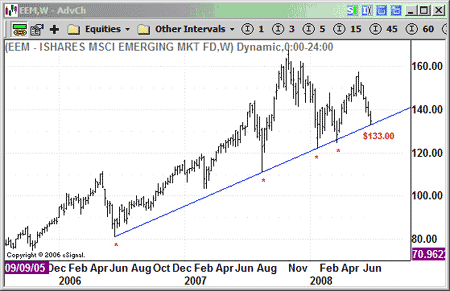
Take out a piece of paper. Write January 1 to June 30, 2008 on it. Now wad it up into a tight ball and launch it across the room as hard as you can. Feel better? That should help relieve some of the tension from a truly awful first half of 2008 – and an even worse month of June alone.
As the first half of 2008 comes to a close today, the major indexes are staggering along, with several major negative forces still continuing to pummel them.
Following last Thursday and Friday’s relentless sell-off, the Dow Industrials dropped to a new low for the year and the index just recorded its worst June performance since the Great Depression. It shed 10% in June – which in technical terms signals an official correction.
It’s also within a whisker of dropping 20% from its 2007 peak, which economists define as a firm bear market signal.
As for the broader S&P 500 index, it got to within 15 points of breaching its own 2008 low, so it’s just another bad day away from joining the Dow.
Another index that made new lows last week was the Russell Top 50 index. Although the Russell indexes are smaller-cap indexes, the Top 50 is constructed in a very similar way to the Dow, so it’s not surprising that it’s also at new lows for the year.
It’s certainly tough to find much good news on US shores at the moment. Aside from the Nasdaq, Dow Transports and smaller-cap indexes, which have held up pretty well so far, many investors can’t wait for the July 4 long weekend.
So I’ve focused my radar on potential overseas opportunities. And although the picture isn’t much prettier, there is one area that could offer some respite to weary investors.
So much for American independence… we’re heading abroad for this opportunity
A quick scan of the world’s leading indexes reveals that most of them are still trading above their 2008 lows.
I have to admit, however, that none of the indexes, both here and abroad, have particularly good-looking charts. For example, when I checked out Europe’s major indexes, I saw that France’s CAC-40 index had also made new lows. Since this index does not include such stocks as Bank of America and American International Group, it raises the odds that the correction has further to go.
Most other indexes are trading below long-term, weekly trendlines. However, I did find one ETF that hasn’t broken down… but is at a very critical area that offers a couple of opportunities.
At the end of a 400% run, emerging markets now have a decision to make
Over the past five years, one stellar ETF performer is the iShares MCSI Emerging Markets Fund (AMEX:EEM). Over that time, it’s surged more than 400%. Since May, however, it’s endured some selling pressure, along with the rest of the world’s indexes.
The fund’s major stock holdings come from assets in Brazil, China, India, South Africa, Russia, Mexico, Taiwan, and South Korea, which make up about 80% of the fund. So you can see that it’s well diversified. However, no more than 15% of its assets come from any one country.
The weekly chart below only accounts for the last two years, but as you can see, there is a clearly defined uptrend line off the June 2006 low, which it’s testing for the third time in 2008.
This means EEM is at a critical decision point.
The Bearish Angle: A weekly close below the trendline, which is $133, would be bearish, bring on more selling, and should see a continuation of the worldwide correction.
The Bullish Angle: There is resistance at the $140 level and if EEM can manage to stay above the trendline and then close above $140, it would provide a good, low-risk buying opportunity. If this occurs, I would use a close below $133 as a stop.
• This article was written by Jim Stanton for the Smart Profits Report.